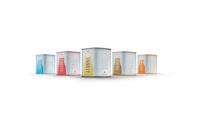Sustainable packaging is getting a lot of attention. But what does it mean, and how can it appeal to consumers?
“Sustainability” is the new buzzword for responsible packaging. The concept received a great boost when Wal-Mart introduced its sustainable packaging initiative last year. Other major retailers are introducing similar initiatives, including Tesco in the United Kingdom.
There are different facets of a package’s ultimate impact on the environment. Some of the most commonly considered ones are source reduction, recyclability, recycled content, carbon footprint and biodegradability. How do each of these facets relate to the others? Which ones are most likely to make significant impacts on consumers? And which ones do food processors see as practical?
Designers, end users and others involved with packaging agree that one of the most significant aspects of today’s “sustainability” approach is the way the different environmental aspects of packaging are intertwined. Bill Franklin, director of the Franklin Associates division of Eastern Research Group based in Lexington, Mass., calls it “life¬cycle analysis.”

“It’s an accounting system that starts with the extraction of resources from the Earth and follows all steps of development through use and end of life,” Franklin says.
Different priorities
However, the emphasis on these different aspects has been evolving. The last big push on “environmentally friendly” packaging took place in the late 1980s and early 1990s, and the most conspicuous aspect was the fear that the U.S. was running out of landfill space. Other concerns have now pushed that one to the background.
The most conspicuous concern is air pollution. Global warming has become arguably the most high-profile environmental issue today. That affects packaging in two main ways: the use of petrochemicals to make packaging and the amount of energy required to process and transport it.
The Wal-Mart metric, for example, tries to quantify this by asking the retailer’s suppliers to specify the distance packaging has to travel before and after its use. But relating energy use to packaging can be tricky, because packaging can affect energy use in many ways.
Roger Zellner, director of sustainability for global technology and quality at Kraft Foods Inc., Northfield, Ill., points out that understanding sustainability in packaging requires evaluating both product and package with a holistic perspective.
For example, he asserts that protecting the product is one of the most important environmental benefits of packaging.
“The product’s environmental footprint in terms of growing, harvesting, processing and distributing is generally larger than that of the package,” he says. “If you have packaging that allows damage and does not sufficiently protect the product, you’re increasing the amount of product loss and environmental impact.”
Another example of holistic understanding is having the right size product portion and corresponding package. Even though more packaging may be needed, the total environmental footprint can be reduced since less product may go to waste.
When done properly, packaging reduction is one of the most promising and popular sustainability strategies for several reasons. In turn, it has a positive impact on other aspects of sustainability.
Zellner explains, “Less material typically requires less energy to produce and transport, and takes up less disposal space.”
Reduced packaging also can be tangible to the consumer, especially if there’s a contrast on retail shelves with a competing product that has more packaging. Additionally, reducing packaging, in most (not all) cases, means reducing packaging costs.
High-profile recycling
The use of sustainable materials is another popular strategy. This encompasses materials that are recycled, recyclable and/or derived from environmentally benign sources.
The use of recyclable materials like PET is a good way to connect with consumers, because recycling is even more visible to consumers than source reduction and other sustainability strategies.
“Probably the one thing [consumers] are confident that they can do that actually helps the environment is putting something into a recycling bin,” Zellner says.
On the other hand, recycling has daunting practical difficulties. Mixing plastics can ruin a recycling batch, which makes it hard, if not impossible, to recycle laminated and coextruded materials. And recycling programs across the U.S. are highly inconsistent in terms of what they take, from whom and how much work the consumer is expected to do.
The degree to which consumers will sacrifice is one of the most vexing variables in sustainable packaging. How much can a consumer goods company ask consumers to give up, in terms of cost, convenience or any other desirable aspect, for a more sustainable package?
Zellner notes that some consumers have shown a willingness to pay more for products they perceive as more environmentally friendly, such as organic food or hybrid vehicles, indicating a desire to make conscientious choices.
“I think it’s pretty well understood that a lot of people will talk green and environmental, but if it’s another 25 or 50 cents [more], people won’t do it,” says Robert Wilkes, president of the Wilkes Creative design agency, Bellevue, Wash.
Barry Seelig, president of the New York-based consultant group applebrandsource, agrees. “There is not a burning interest in sustainability,” Seelig says. “If it comes to convenience over sustainability, they’re going to pick convenience.”
No tradeoffs
This state of affairs leads many food processors to be wary of asking consumers to do too much in the name of sustainability.
“We are unwilling to have any tradeoffs,” says Clifford Henry, associate director of global sustainability for Procter & Gamble, based in Cincinnati. “Our primary goal is to delight consumers. I’ve heard others say you can provide products that aren’t as nice or make some compromises, but we’re not willing to do that. ... The bottom line for us is no tradeoffs in trying to understand the packaging.”
In many cases, it’s easier to implement sustainable packaging initiatives overseas, especially in Europe, than in the U.S. This is partly because European consumers generally place a higher priority on environmental issues, and partly because European regulations are more stringent.
Sustainability in packaging also is more of a fit with certain products, such as organic or “natural” foods, that appeal to consumers who are inclined to care about environmental issues.
But when considering how they should think about sustainability, Zellner says, some consumers today may feel overwhelmed and become skeptical.
“Consumers hear or see a lot of different terms such as recyclable, recycled content, renewable, biodegradable, compostable,” he says. “One of our goals is to better understand how to communicate environmental packaging benefits that resonate with consumers and help them make environmentally friendly choices.”
Seelig suggests that when it comes to sustainability, consumer goods companies may have to take more initiative than they’re used to doing.
“I think you have to have a radical change within the CPG [consumer packaged goods] companies,” he says. “It doesn’t happen with one division. It doesn’t happen with the innovation group or your sustainability group. It really has to be a totally new mindset from top to bottom.”


